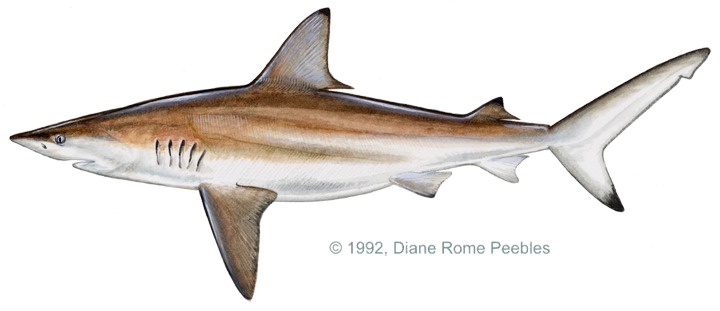Game Fish Identification Reference Guides
Shark, whaler
(Carcharhinidae family)
(Carcharhinidae family)

Includes 50 species; also known as requiem sharks, requins, cazones picudos, tiburones, tintorereas; some individual species … gray reef , narrowtooth, spinner, silky, Galapagos, bull, blacktip, oceanic whitetip, blacktip reef, dusky, Caribbean reef, sandbar, tiger, lemon, blue, whitetip reef, milk, sicklefin lemon
Whalers, or requiem sharks, all members of the genus Carcharhinus, are a group of closely- related sharks, which present identification difficulties. There are 12 genera and at least 50 species in this family, many with worldwide distribution and targeted by sportfishermen. Most are pelagic in tropical and warm temperate areas, a few are oceanic while at least one can penetrate far into fresh water. The most important identifying features are tooth shape and number, position of the dorsal fins, color and the presence or absence of an interdorsal ridge. Whales are typically viviparous, with a yolk-sac placenta (tiger sharks are an exception, being ovoviviparous). The Carcarhinidae family contains three of the four shark species most dangerous to humans.
Whalers are small to large sharks with fusiform bodies, round eyes, internal nictitating eyelids, ventrally placed mouths extending past the eyes, no nasoral grooves or barbles, usually no spiracles, moderately long labial furrows, small to large, more or less blade-like teeth in both jaws, often broader in the upper jaw, five gill openings, the fifth behind origin of pectoral fin. Two dorsal fins and an anal fin, the first dorsal fin moderate-sized to large and with its base well ahead of pelvic bases, the second dorsal fin usually much smaller than the first, precaudal pits present, caudal fin with a strong ventral lobe and lateral undulations on its dorsal margin. The intestine with a scroll-type valve and usually no color pattern.
All tackle records will be given to those positively identified to species level. Anglers submitting record applications should supply good lateral photographs of the shark, and photographs of the underside of the head and interdorsal area, the space between the first and second dorsal fins. At least six adjacent teeth taken from the center of the upper jaw would also aid in positive identification.
Whalers, or requiem sharks, all members of the genus Carcharhinus, are a group of closely- related sharks, which present identification difficulties. There are 12 genera and at least 50 species in this family, many with worldwide distribution and targeted by sportfishermen. Most are pelagic in tropical and warm temperate areas, a few are oceanic while at least one can penetrate far into fresh water. The most important identifying features are tooth shape and number, position of the dorsal fins, color and the presence or absence of an interdorsal ridge. Whales are typically viviparous, with a yolk-sac placenta (tiger sharks are an exception, being ovoviviparous). The Carcarhinidae family contains three of the four shark species most dangerous to humans.
Whalers are small to large sharks with fusiform bodies, round eyes, internal nictitating eyelids, ventrally placed mouths extending past the eyes, no nasoral grooves or barbles, usually no spiracles, moderately long labial furrows, small to large, more or less blade-like teeth in both jaws, often broader in the upper jaw, five gill openings, the fifth behind origin of pectoral fin. Two dorsal fins and an anal fin, the first dorsal fin moderate-sized to large and with its base well ahead of pelvic bases, the second dorsal fin usually much smaller than the first, precaudal pits present, caudal fin with a strong ventral lobe and lateral undulations on its dorsal margin. The intestine with a scroll-type valve and usually no color pattern.
All tackle records will be given to those positively identified to species level. Anglers submitting record applications should supply good lateral photographs of the shark, and photographs of the underside of the head and interdorsal area, the space between the first and second dorsal fins. At least six adjacent teeth taken from the center of the upper jaw would also aid in positive identification.












